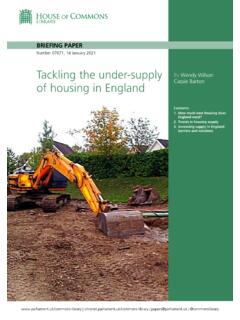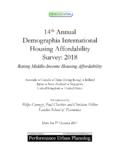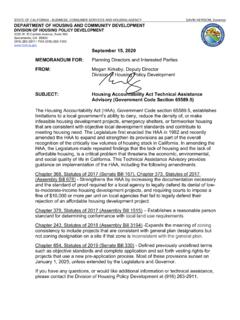Transcription of Public Works Loan Board - GOV.UK
1 Public Works Loan Board : future lending terms March 2020. Public Works Loan Board : future lending terms March 2020. Crown copyright 2020. This publication is licensed under the terms of the Open Government Licence except where otherwise stated. To view this licence, visit government-licence/version/3. Where we have identified any third party copyright information you will need to obtain permission from the copyright holders concerned. This publication is available at: Any enquiries regarding this publication should be sent to us at ISBN 978-1-913635-13-8. PU2953. Contents Foreword 2. Executive summary 4. Chapter 1 Background 6. Chapter 2 Recent developments 9. Chapter 3 Proposed new PWLB lending terms 13. Chapter 4 The wider PWLB offer 21. Chapter 5 Other questions 26. Annex B Affected borrowers 30. Annex C Processing of personal data 31. 1. Foreword Local government plays an essential role in delivering Public infrastructure across the United Kingdom, investing billions of pounds every year in the construction and maintenance of local roads, parks, schools, the regeneration of their local areas, and other Public services.
2 Local authorities have long owned buildings that could serve a commercial purpose, and they often use commercial structures to advance their core role in delivering Public services, housing, and regeneration to the benefit of citizens and taxpayers. The government is committed to continuing to support this valuable investment. However, a recent report by the National Audit Office (NAO) highlights how a minority of local authorities have started using low-cost loans from the Public Works Loan Board (a Public body that lends to local authorities for capital projects) to buy investment property primarily for rental income. The case for this debt-for-yield' activity can be compelling for the individual local authority. But it introduces risks locally and nationally. At the local level, it exposes ratepayers to the risk that the income does not materialise, leaving the local authority with an inflexible commitment to keep up with the repayments on their loans.
3 Within the wider Public sector, it diverts money from core services such as schools, hospitals, and roads. And, because local authorities can often access debt more cheaply than the private sector, it becomes hard for businesses to compete. In the wider economy, it could crowd out Public investment, and risks distorting property markets. The government has launched this consultation to work with local authorities, sector representatives, and wider stakeholders to develop a targeted intervention to stop this activity while protecting the crucial work that local government does on service delivery, housing, and regeneration. The government's overall aim in this is to secure the effective operation of 2. the prudential system for local councils, taxpayers and for all of us that rely on local services. As part of this consultation, the government will run a series of regional roundtables with local authorities in England, Scotland, Wales, with MHCLG, the Scottish Government, the Welsh Government, and CIPFA.
4 Alongside the publication of this consultation, the government is cutting the interest rate on new loans for social housing and has offered over 1 billion of discounted lending for high-value local infrastructure projects. The government intends to cut the interest on all new loans from the PWLB, subject to market conditions, following the development and implementation of a robust lending framework co-designed with the sector through this consultation. 3. Executive summary Local decision-making is a core principle of the local government finance system and offers clear advantages over the more centralised approaches of the past. The government is committed to this localised approach. However, local authority (LA) borrowing has grown substantially in recent years, led by a minority of LAs borrowing from the Public Works Loan Board (PWLB) to buy investment assets primarily for yield. The government is therefore consulting on a limited intervention to address the specific issue (described in this document as debt-for-yield') so that the PWLB can continue to support LA investment in service delivery, regeneration, and housing, without impinging on the powers and freedoms that LAs use to deliver local services in innovative ways.
5 The government will work with the sector through this consultation and a series of regional workshops to develop a solution that resolves the debt-for- yield issue without impinging on the wider freedoms of the sector. As a starting point, the government proposes: a. requiring LAs that wish to access the PWLB to confirm that they do not plan to buy investment assets primarily for yield b. publishing guidance defining the activity that the PWLB will no longer support, with clear protections for service delivery, regeneration, housing, and the refinancing of existing debt c. standardising the information currently gathered through the application process for the PWLB Certainty Rate and using this as the primary way to confirm with LAs that their plans conform with the guidance LAs that wish to buy investment assets primarily for yield would remain free to do so but would not be able to take out new loans from the PWLB in the year in which they have bought the asset.
6 Any loans taken out under the old system would not be affected by this change. This change is only intended to apply to capital spending treasury management strategies are not affected. This change would only apply to larger authorities in England, Scotland, and Wales. The government does not propose any change to the PWLB lending 4. arrangements for smaller LAs (used here to mean parishes, town and community councils, and drainage boards) as the debt-for-yield issue seems to be limited to larger authorities. The government intends to lower the interest rate on new PWLB loans, subject to market conditions, once a new system can be introduced to address the debt-for-yield issue. The Ministry of Housing, Communities and Local Government (MHCLG) is planning to undertake a project of work to improve its understanding of borrowing and investment activity. This will be done through a planned review which will explore what additional data can be collected in order to develop a more comprehensive understanding of LA borrowing and investment activity.
7 This work will form an evidence base which can be used, in consultation with the sector and working with HM Treasury, to gather further evidence about the wider functioning of the prudential framework. Responding to this consultation This consultation will run for twelve weeks, ending on Friday 31 July 2020. Please submit responses to this consultation via the online tool, available here: Board -future-lending-terms-consultation Responses will also be accepted via email to or by post to: PWLB consultation HM Treasury One Horse Guards Road London SW1A 2HQ. Information on how we handle your information is given in Annex C of this document 5. Chapter 1. Background The local government finance system relies on the principle of local decision-making and accountability. Local authorities have broad discretion to determine how they deliver services, on the principle that they are best placed to decide how to invest to support their local communities. These freedoms include: a.
8 Powers introduced in the Local Government Act 1972 that give LAs the ability to acquire land for any of their functions or for the benefit, improvement or development of their area b. powers introduced in the Local Government Act 2003 that give LAs wide freedoms to borrow without the need to seek government approval, provided it is within the statutory bounds of the principles-based Prudential Framework'. Investment decisions must be consistent with the relevant legislative provisions regarding investment powers. LAs can borrow in Sterling from any source, provided the borrowing is within self-determined affordability limits. These freedoms allow LAs to determine how to fund their capital strategies at the local level c. the General Power of Competence introduced in 2011 allows LAs to do anything that individuals generally may do'. Decisions over which capital projects to pursue and whether to borrow to finance them are the responsibility of the elected Council of each LA.
9 This system of local decision-making is known as the prudential regime. In addition, LAs can only borrow for capital and must repay all borrowing from revenue. There is a statutory ban on LAs pledging capital assets such as land or buildings as collateral. These rules put a natural limit on the levels of debt and borrowing each authority can take on. The government is supportive of LAs using commercial approaches to deliver Public services efficiently or to protect cash balances from the effects of inflation. But LAs should not enter into financial arrangements which serve no direct policy or treasury management purpose. 6. In 2018 the MHCLG updated the statutory guidance on local government investments in response to an increase in borrowing and investment by The aim of the update was to ensure that the control system for LA borrowing and investment activity remained sufficiently robust and relevant to the current landscape. The changes were: a.
10 A new requirement for councils to prepare an investment strategy and a capital strategy annually b. a required disclosure around the contribution that investments make to service delivery c. quantitative indicators to be included in order to enable decision- makers and members of the Public to understand the performance of and risks associated with investment activity. (These indicators are not prescribed but some suggestions are included with the guidance). d. an extension of the requirements on capacity and skills to members and any statutory officers involved in or responsible for signing off investment decisions e. clarification around borrowing in advance of need The role of the Public Works Loan Board Central government supports local investment in part by offering low cost loans to LAs through the Public Works Loan Board . The PWLB is the main lender to local government, accounting for around two thirds of LA debt. The application process is currently deliberately permissive: if the finance director of the applicant authority can confirm that they are acting in line with statute and can afford to repay the loan from their revenues, the PWLB will issue the loan within two working days.















